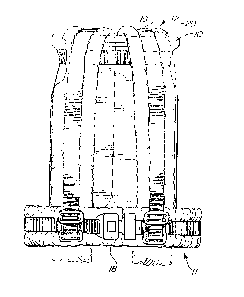Une partie des informations de ce site Web a été fournie par des sources externes. Le gouvernement du Canada n'assume aucune responsabilité concernant la précision, l'actualité ou la fiabilité des informations fournies par les sources externes. Les utilisateurs qui désirent employer cette information devraient consulter directement la source des informations. Le contenu fourni par les sources externes n'est pas assujetti aux exigences sur les langues officielles, la protection des renseignements personnels et l'accessibilité.
L'apparition de différences dans le texte et l'image des Revendications et de l'Abrégé dépend du moment auquel le document est publié. Les textes des Revendications et de l'Abrégé sont affichés :
| (12) Brevet: | (11) CA 1292097 |
|---|---|
| (21) Numéro de la demande: | 1292097 |
| (54) Titre français: | VESTE DE SECURITE, EN EQUIPEMENT DE VEHICULE AUTOMOBILE, A L'INTENTION D'UN ENFANT VOYAGEANT A BORD DU VEHICULE |
| (54) Titre anglais: | CHILD'S SAFETY RESTRAINING VEST |
| Statut: | Périmé et au-delà du délai pour l’annulation |
| (51) Classification internationale des brevets (CIB): |
|
|---|---|
| (72) Inventeurs : |
|
| (73) Titulaires : |
|
| (71) Demandeurs : |
|
| (74) Agent: | SMART & BIGGAR LP |
| (74) Co-agent: | |
| (45) Délivré: | 1991-11-19 |
| (22) Date de dépôt: | 1988-08-16 |
| Licence disponible: | S.O. |
| Cédé au domaine public: | S.O. |
| (25) Langue des documents déposés: | Anglais |
| Traité de coopération en matière de brevets (PCT): | Non |
|---|
| (30) Données de priorité de la demande: | ||||||
|---|---|---|---|---|---|---|
|
ABSTRACT OF THE INVENTION
A child's safety vest is disclosed for use in automobiles
and other vehicles having lap-belt passenger restraining systems.
A stress plate, which attaches to the lap belt, forms a vertical
sub-frame to support and secure a waist band and shoulder bands
which encircle the child wearer. The stress plate is preferably
formed of sheet metal material and a padded front, and the waist
and shoulder bands are adjustable to accommodate children of
varying sizes.
Note : Les revendications sont présentées dans la langue officielle dans laquelle elles ont été soumises.
Note : Les descriptions sont présentées dans la langue officielle dans laquelle elles ont été soumises.

2024-08-01 : Dans le cadre de la transition vers les Brevets de nouvelle génération (BNG), la base de données sur les brevets canadiens (BDBC) contient désormais un Historique d'événement plus détaillé, qui reproduit le Journal des événements de notre nouvelle solution interne.
Veuillez noter que les événements débutant par « Inactive : » se réfèrent à des événements qui ne sont plus utilisés dans notre nouvelle solution interne.
Pour une meilleure compréhension de l'état de la demande ou brevet qui figure sur cette page, la rubrique Mise en garde , et les descriptions de Brevet , Historique d'événement , Taxes périodiques et Historique des paiements devraient être consultées.
| Description | Date |
|---|---|
| Inactive : Renversement de l'état périmé | 2012-12-05 |
| Le délai pour l'annulation est expiré | 2008-11-19 |
| Lettre envoyée | 2007-11-19 |
| Accordé par délivrance | 1991-11-19 |
Il n'y a pas d'historique d'abandonnement
| Type de taxes | Anniversaire | Échéance | Date payée |
|---|---|---|---|
| TM (catégorie 1, 6e anniv.) - petite | 1997-11-19 | 1997-10-03 | |
| TM (catégorie 1, 7e anniv.) - petite | 1998-11-19 | 1998-10-07 | |
| TM (catégorie 1, 8e anniv.) - petite | 1999-11-19 | 1999-10-04 | |
| TM (catégorie 1, 9e anniv.) - petite | 2000-11-20 | 2000-10-03 | |
| TM (catégorie 1, 10e anniv.) - petite | 2001-11-19 | 2001-10-05 | |
| TM (catégorie 1, 11e anniv.) - petite | 2002-11-19 | 2002-10-17 | |
| TM (catégorie 1, 12e anniv.) - petite | 2003-11-19 | 2003-10-20 | |
| TM (catégorie 1, 13e anniv.) - petite | 2004-11-19 | 2004-10-26 | |
| TM (catégorie 1, 14e anniv.) - petite | 2005-11-21 | 2005-10-26 | |
| TM (catégorie 1, 15e anniv.) - petite | 2006-11-20 | 2006-10-25 |
Les titulaires actuels et antérieures au dossier sont affichés en ordre alphabétique.
| Titulaires actuels au dossier |
|---|
| T & H, INC. |
| Titulaires antérieures au dossier |
|---|
| FRED J. HUSPEN |
| LORA LEE THOMAS |